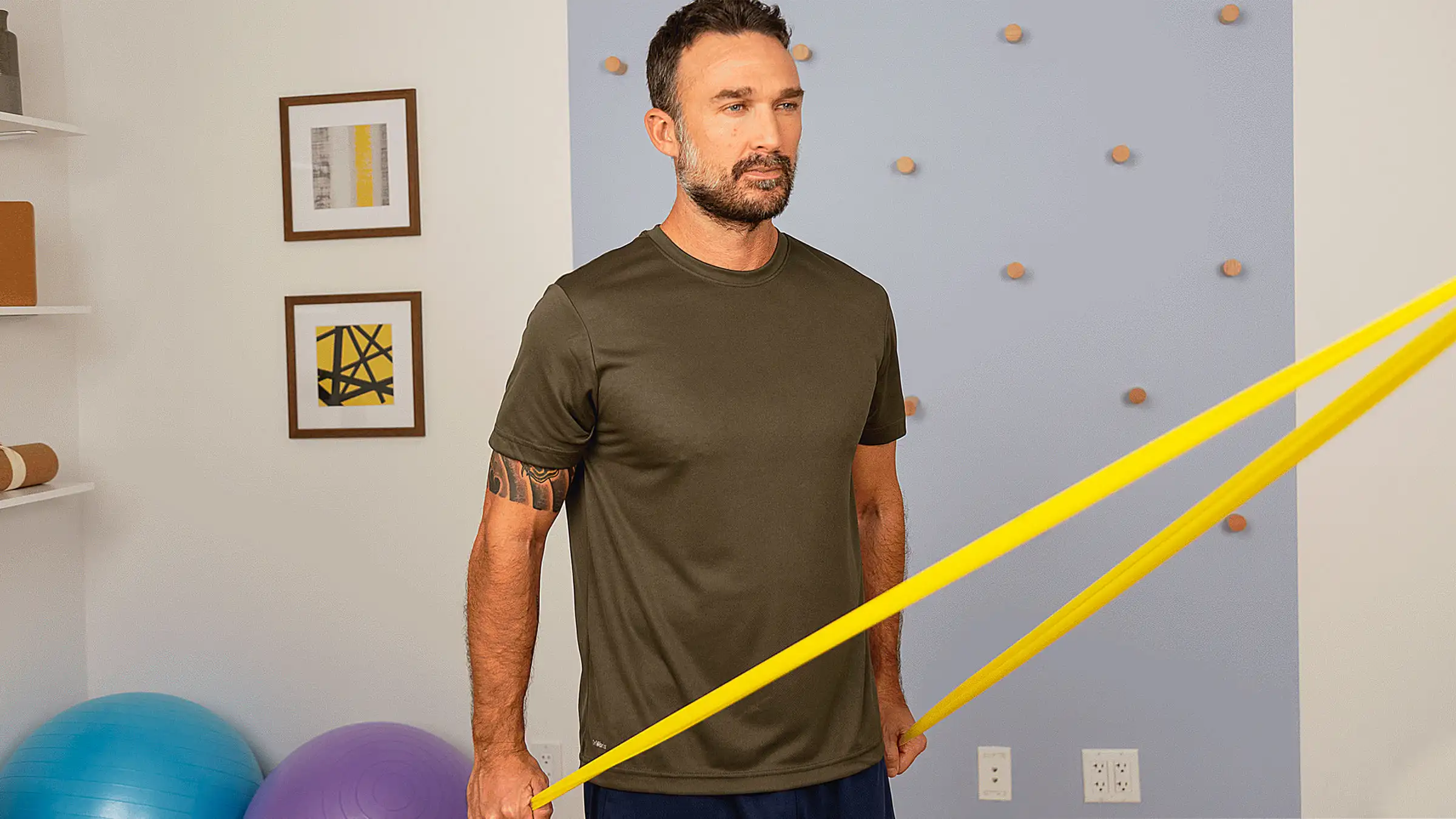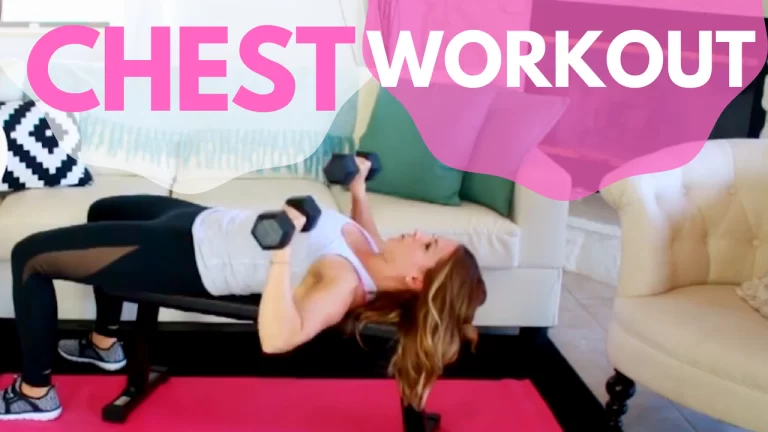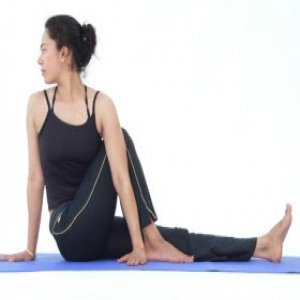32 Best Exercises For Rotator Cuff Tendinitis
Effective management of rotator cuff tendinitis often involves a combination of rest, physical therapy, and specific exercises aimed at strengthening the muscles surrounding the shoulder joint and improving flexibility. However, not all exercises are suitable for individuals with rotator cuff tendinitis, as some movements may exacerbate symptoms and further aggravate the condition.
Rotator cuff tendinitis is a common cause of shoulder pain and discomfort, often resulting from overuse, injury, or improper shoulder mechanics during physical activities. A collection of tendons and muscles called the rotator cuff helps to support the shoulder joint and promotes easy arm movement. When these tendons become inflamed or irritated, it can lead to pain, weakness, and restricted range of motion in the shoulder.
In this guide, we will explore some of the best exercises for rotator cuff tendinitis, focusing on gentle strengthening and stretching movements that can help alleviate pain, improve shoulder function, and prevent future injury.
Introduction
The most common cause of shoulder pain is inflammation of the significant shoulder tendons or rotator cuff tendonitis. When you pull, push, reach up, or raise your arm to the side, you first experience an uncomfortable aching around the outside point of your shoulder. The pain in your shoulder hurts to rest on as well and if you move onto it at night, the pain can wake you up. It can be challenging to even put on clothes. At some point, the pain could get worse and affect the entire shoulder.
The rotator cuff, made up of four muscles, increases the range of motion and supports the stability of the glenohumeral joint. After surgery or an injury, you may get back to your regular activities and live a healthier, more active lifestyle with the help of an exercise conditioning program. Following a carefully planned conditioning program may also make it easier for you to resume sports and other outdoor activities.
Strength: Maintaining the stability of your shoulder joint can be achieved by strengthening the muscles that support it. Maintaining the strength of these muscles helps reduce shoulder pain and stop more damage.
Flexibility: Stretching is necessary to restore range of motion and protect your body after your muscles have been strengthened. Stretching your muscles gently after strengthening activities can help keep them long and flexible while reducing pain.
Target Muscle Groups:
The following muscle groups are the key focus of this conditioning program:
- Deltoids (front back and over the shoulder)
- Trapezius muscles (upper back)
- Rhomboid muscles (upper back)
- Teres muscles (stabilize the shoulder joint)
- Supraspinatus (a muscle that supports the shoulder joint)
- Infraspinatus (a muscle that aids with shoulder joint stability)
- Subscapularis (shoulder blade)
- Biceps (upper arm’s front)
- Triceps (upper arm back)
What purposes do the muscles of the rotator cuff carry out?
Many different upper-body movements, such as flexion, extension, abduction, internal and external rotation, and many more, are made possible by the cooperation of your rotator cuff muscles. The role they play is important in maintaining the stability of your shoulder joint and the placement of your humerus within the small glenoid fossa of your scapula.
All movements related to the shoulder involve them. A rotator cuff muscle group that is not properly engaged can cause shoulder pain and discomfort, as well as limited or decreased athletic skills. It could also harm your quality of life and break your routine.
Which clinical examinations are commonly used to identify tendinitis of the rotator cuff?
The tests that doctors most frequently apply to identify rotator cuff injuries are listed below.
Hawkins-Kennedy test:
- The Hawkins-Kennedy test is a diagnostic tool for shoulder impingement syndrome.
Neer’s test:
- Shoulder impingement syndrome is evaluated and diagnosed using this test.
Empty can test:
- The purpose of this test is to evaluate the shoulder for suspected rotator cuff tears and damage.
External rotation:
- A source of discomfort or weakness.
Painful arc sign:
- This test was developed to figure out whether a rotator cuff tear is possible.
Benefits of doing rotator cuff exercises:
- The muscles in your shoulder joint will grow stronger as a result of this exercise.
- Reduces pain in the shoulder joints. This exercise will improve the support your strong muscles provide for your joints by strengthening your muscles.
- Maintains routine actions like pushing and pulling things to help with performance maintenance.
- Maintains the health of the cartilage. For joint cartilage to remain healthy, It needs to be relocated and handled carefully. Similar to how water gathers in a sponge, synovial fluid does the same in cartilage.
- Improves the function and range of motion of the shoulder joint.
- Exercise helps with posture.
- This workout reduces pain by building muscle and preventing bone dislocation and irritation.
Best Exercises For Rotator Cuff Tendinitis
The best workouts for dealing with rotator cuff tendinopathy are listed below:
Doorway stretch
- Spread your arms out to the sides while standing in an open doorway to warm up your muscles.
- Lean forward through the doorway until you feel a slight stretch, then using both hands, hold the sides of the doorway at or near shoulder height.
- As you recline and shift your weight onto your toes, maintain a straight back.
- A stretch in the front of your shoulder should be felt.
- Avoid going too far.
- Hold this posture for a brief time.
- Return to your neutral position after that.
- Then relax.
- Repeat these exercises five to ten times.
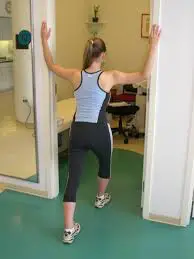
Side-lying external rotation
- Place yourself on the side that is not wounded.
- Your damaged arm’s elbow should be 90 degrees bent and rested on your side.
- Place your forearm over your abdomen.
- Using the affected side of the hand, hold a light dumbbell and slowly elevate it toward the ceiling while maintaining your elbow pressed against your side.
- If you start to feel stressed stop rotating your arm.
- After a short while, take the dumbbell out and lower your arm to resume the starting position.
- Then relax.
- Repeat these exercises five to ten times.
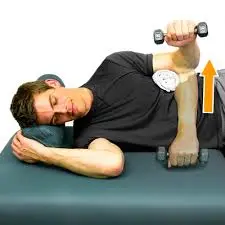
High to low rows
- A resistance band should be fixed to a sturdy object at or above shoulder height.
- Make sure it’s secure enough that pulling on it won’t cause it to come loose.
- As you lower yourself to one knee, raise the knee across from your damaged arm.
- Your lowered knee should be in line with your body.
- With your knee lifted, place the other hand down.
- Extending your arm to grasp the band firmly, bring your elbow close to your torso.
- Squeeze your shoulder blades down and together while pulling, maintaining a straight back.
- Arm movement or twisting should not happen to your body.
- Return to your neutral position after that.
- Then relax.
- Repeat these exercises five to ten times.
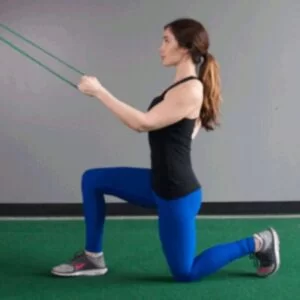
Pulling a lawnmower
- As you stand, spread your feet shoulder-width out.
- Put a resistance band under the foot on the other side of your affected arm.
- With the injured arm towards you, hold the other end of the band so that it crosses your body vertically.
- Keep your other hand on your hip and avoid locking your knees as you flex your waist slightly to position the hand holding the band parallel to the opposing knee.
- Stand up straight and draw your elbow across your body to your outside ribs, similar to how a slow-motion lawnmower would be started.
- As you stand, press your shoulder blades together while maintaining a relaxed posture.
- Return to your neutral position after that.
- Then relax.
- Repeat these exercises five to ten times.

Arm reach
- You can lie in a supine position and perform this exercise.
- Stretch your arms and legs and tense your abdominal muscles.
- Raise your left arm up toward the sky until your shoulder blade lifts off the ground.
- Hold on for a duration of five seconds.
- Arm back to the floor and return to your neutral position after that.
- Then relax.
- On the right side, do the same.
- Repeat these exercises five to ten times.
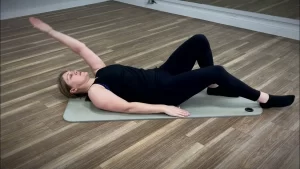
Pendulum
- Lean forward while standing, leaving your left arm free, to perform the pendulum exercise.
- Hold yourself up against a table with your other arm to provide support.
- Swing the hanging arm smoothly in a forward, backward, and circular motion from the lateral to the medial side.
- Return to your starting position slowly.
- Then relax.
- Continue on the opposite side.
- Repeat these exercises five to ten times.

Arm crossover exercise
- Raise one arm straight up and parallel to the floor, do not lock it in place.
- Using the other hand, grab the extended, raised arm by the wrist.
- Try to hug the chest with the arm as you slowly pull it across the front of the body.
- After holding the stretch for five seconds, release it gradually.
- Return to your starting position slowly.
- Then relax.
- Continue on the opposite side.
- Repeat these exercises five to ten times.
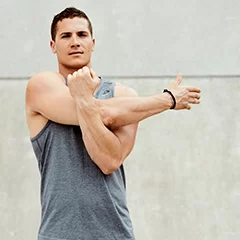
Passive Internal Rotation
- You will feel a stretch in the front of your shoulder as you perform this exercise, which mainly targets your subscapularis.
- Grasp the other end of a stick with one hand while holding it behind your back with the other.
- By pulling the stick horizontally, you can passively stretch your shoulder.
- Recognize the pull that this movement is creating.
- Hold on for a duration of a few seconds.
- Return to your starting position slowly.
- Then relax.
- Continue on the opposite side.
- Repeat these exercises five to ten times.
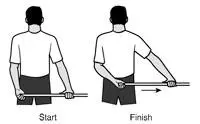
Passive External Rotation
- Your teres minor and infraspinatus muscles are the main targets of this exercise.
- You should feel a stretch in the back of your shoulder while doing this.
- Grasp one end of a stick with one hand while touching the other end.
- Push the stick horizontally while maintaining the elbow of the shoulder you are stretching against your side of the body.
- Retract your shoulder by feeling the pull.
- Hold on for a duration of a few seconds.
- Return to your starting position slowly.
- Then relax.
- Continue on the opposite side.
- Repeat these exercises five to ten times.

Sleeper Stretch
- The infraspinatus and teres minor muscles are also worked on by this exercise.
- With the injured shoulder underneath you and your arm bent, you should lie on your side on a solid, level surface.
- Push down with your other arm on the side you are lying on, feeling the strain in the back of the injured shoulder.
- After about a few seconds of holding this position, release your arm and let it drop for another few seconds.
- Return to your starting position slowly.
- Then relax.
- Continue on the opposite side.
- Repeat these exercises five to ten times.
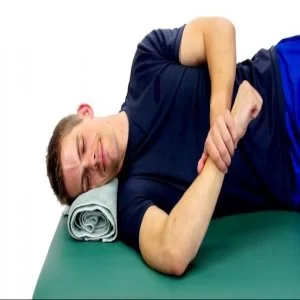
Reverse Fly’s
- Dumbbells must be held in order to perform a reverse fly.
- Step out with your feet shoulder-width apart and your knees slightly bent.
- Maintain a straight back and a slight hip flexion.
- Extend your arms away from your body while holding a dumbbell in both hands, do not bend your elbows.
- Try not to raise your arms higher than shoulder level while you squeeze your scapula together.
- Return to your starting position slowly.
- Then relax.
- Continue on the opposite side.
- Repeat these exercises five to ten times.
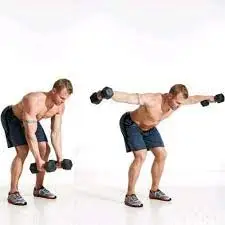
Posterior Stretch
- Lift your shoulders and stand up.
- The hand of the uninjured arm holds the damaged elbow part in place.
- After crossing the body, the injured arm’s hand rests on the shoulder across from it.
- Stretching takes place when the affected arm is gently pushed up and over the body by the hand of the uninjured arm.
- Return to your starting position slowly.
- Then relax.
- Using the other arm, repeat the exercise.
- Repeat these exercises five to ten times.

Inverted Row
Straps, barbell or gymnastic facets can be used to extend from the top of the ceiling, or you can hang from a flying broomstick that is positioned over two sturdy chairs.
- To get your preferred position, adjust the barbell. Start by measuring your waist.
- You will be able to fully extend your arms and keep your body off the ground by doing this.
- Take a seat below the bar. Look at your overhead ceiling.
- Raise your hand to grab the bar.
- You should be able to hold the barbell with an overhand grip by fully extending your arms.
- Your body will be hanging or slightly elevated, with your heels being your only point of contact with the ground below.
- Squeeze your butts and abdominal muscles to support your lower back and maintain a straight body from the waist to the feet.
- As you raise yourself, lead with your chest.
- When performing the top movement, the barbell or rings can be lifted to chest height.
- Your body maintains a straight line throughout the entire exercise, and your core and glutes tighten.
- You don’t have to touch your chest with the barbell.
- Bring it as near as you can.
- After holding for two seconds and confirming that the scapula should retract, slowly lower yourself to the starting position while keeping your arms fully extended.
- Then relax.
- Repeat these exercises five to ten times.
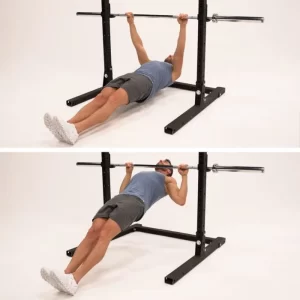
Dumbbell Lateral Raise
- Bend forward while holding a dumbbell in each hand.
- With your palms facing in, place your arms by your sides.
- Set the distance between your feet equal to the width of your hips.
- Check the proper positioning of your body.
- Pull your shoulders back, tense your abdominal muscles, and look directly ahead.
- At the same time raise your arms two inches to each side.
- As you raise and extend the weight to each side, your arms should be nearly fully extended.
- Stop when your elbows are shoulder height and your body forms a “T” shape.
- Lifting the arm causes you to inhale.
- Hold that position at the peak of the movement for two seconds.
- Easily As you lower the dumbbell, bring your hands back to your sides.
- Breathe out as you bring the weight down.
- Return to your starting position slowly.
- Then relax.
- Repeat these exercises five to ten times.
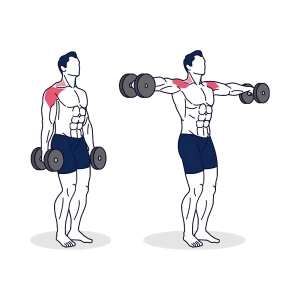
Wall push-ups
- You must stand facing a wall, ten to fifteen inches away, to complete this exercise.
- Put both of your palm’s shoulder height on the wall.
- Bend your elbows slowly and turn your face toward the wall.
- You should have a straight lower body.
- Return to your starting position slowly.
- Then relax.
- Repeat these exercises five to ten times.
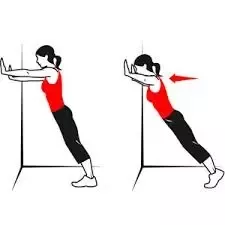
Retraction scapular
- An elastic exercise band, like a Thera-Band or therapeutic cables, can be used for this retraction scapular exercise.
- About trunk level, wrap the band around a stable object.
- Using both hands, grasp one end of the elastic band.
- Pull the elastic band back while maintaining a 90-degree flexion with your elbows by your sides.
- Move your scapulae in the direction of one another.
- After that, extend your arms backward to where you were before.
- Return to your starting position slowly.
- Then relax.
- Repeat these exercises five to ten times.
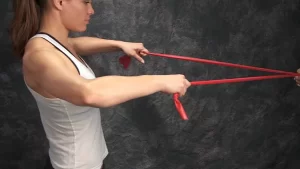
Wand exercise
For, Flexion:
- To complete this exercise, you must hold a stick with both hands while standing up straight, with the palms facing downward.
- Raise both arms above your head to extend them.
- Your elbows should be straight.
- After five seconds of holding, go back to where you were.
- Return to your starting position slowly.
- Then relax.
- Repeat these exercises five to ten times.
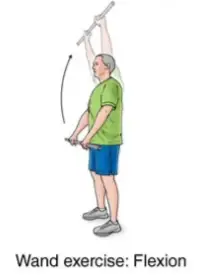
For, Extension:
- You can complete this exercise by Holding a stick behind your back with both hands while standing straight.
- Move the stick that’s behind you.
- For five seconds, maintain this stance.
- After five seconds of holding, go back to where you were.
- Return to your starting position slowly.
- Then relax.
- Repeat these exercises five to ten times.
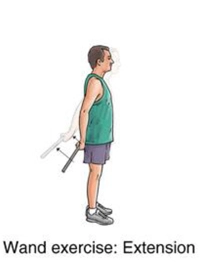
Shoulder abduction and adduction
- You can complete this exercise by Holding a stick in both hands, palms away from the body while standing erect.
- Place the stick up against your front thighs.
- With both elbows straight, push your other arm as far up and to the side as you can with one arm.
- Take a few seconds to maintain this position.
- Return to where you started.
- Then relax.
- Repeat these exercises five to ten times.

Horizontal abduction
- Laying face down on a table or the edge of a bed, you are able to perform this exercise by hanging your arm straight down to the floor.
- Pull your arm up to the side until it is collateral to the surface, keeping your thumbs pointing skyward.
- After three to four seconds of holding, slowly down.
- Return to where you started.
- Then relax.
- Repeat these exercises five to ten times.

Supported shoulder extensor stretch
- Grasp a firm surface from a distance of approximately arm’s length.
- A doorknob, a countertop, or the rear of a sturdy chair would all work well.
- Bend forward with straight arms and slightly bent knees.
- Let your shoulders stretch as you lower your upper body.
- You might need to take one or two steps backward as your shoulders can extend further.
- For a few seconds, hold.
- To maintain your hands on the solid surface, take a step forward when you stand up if you step back during your stretch.
- Next, get up and relax.
- Repeat these exercises five to ten times.

Wall climb (to the side)
- Take a position with your injured shoulder about an arm’s length apart from the wall.
- As far as your pain lets you, raise your affected arm to the wall at an angle of about thirty degrees in front of you.
- Instead of shrugging, Be relaxed and maintain a low shoulder.
- Stay straight and refrain from leaning to one side.
- For a few seconds at minimum, maintain that stance.
- Go back to where you started with your fingers, slowly.
- Return to where you started.
- Then relax.
- Repeat these exercises five to ten times.

Shoulder-blade squeeze
- With your arms by your sides, take a straight seat or stand up.
- Don’t shrug, instead, keep your shoulders down and relaxed.
- Bring your shoulder blades together and downward.
- Hold for a few seconds, then release your grip.
- Return to your starting position slowly.
- Then relax.
- Repeat these exercises five to ten times.

Scapular arm reach (lying down)
- On a firm surface, such as the floor or a firm bed, lie on your back.
- You can place a pillow beneath your knees or bend them.
- Lift your arm and reach up toward the ceiling.
- Make sure your elbows are straight.
- You should only move from your shoulder blades.
- Your shoulders will slightly lift off the ground or the bed.
- Put your arms back in the beginning position as you gradually relax.
- Repeat these exercises five or ten times.
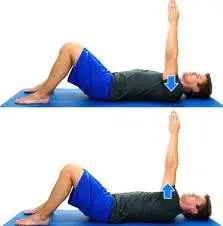
Isometric shoulder flexion
- Stand yourself facing a wall.
- Make a fist with your elbow bent on the shoulder you wish to work out.
- Press your palm lightly into the wall with a folded towel between your fist and the wall.
- Holding for five seconds, then gently releasing.
- Return to your starting position slowly.
- Then relax.
- Repeat these exercises five or ten times.
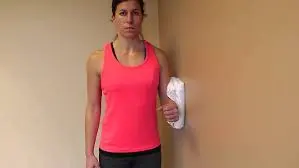
Extension of the shoulder (isometric)
- Place your back to a wall and stand about six inches far from it.
- In order that your hand is down close to your hip, maintain a straight elbow.
- Gently press your fist against the wall behind you.
- Your shoulder should not move very much.
- After five seconds of holding the pressure against the wall, gradually release it.
- Return to your starting position slowly.
- Then relax.
- Do this exercise five to ten times over.
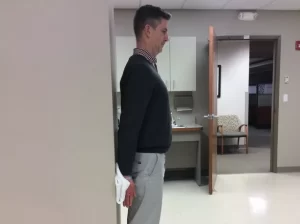
Resisted shoulder external rotation
- Sideways stand close to a door.
- Put the hand that is the furthest from the door across your abdomen.
- Using that hand, grab the waist-level cable that is attached to a doorknob.
- Keeping your elbow by your side, move your arm outward and away from your waist.
- Maintain a 90-degree bowed elbow and your forearm in line to the ground.
- Return to your starting position slowly.
- Then relax.
- Do this exercise five to ten times over.
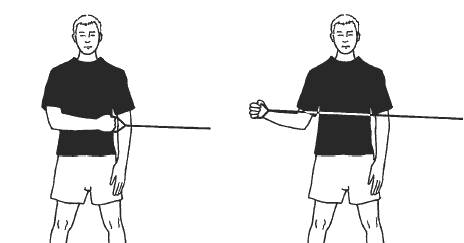
Resisted shoulder internal rotation
- With a resistance band attached to the side of your weakened arm, stand straight.
- Make a 90-degree bend with your weakened elbow.
- In your weakened arm, take an adjusted resistance band.
- Rotate your forearm into your body while maintaining your elbow by your side.
- Hold this posture and then rotate your forearm away from you, allowing the band to gently rebound.
- In the exercise, maintain a straight back and stay away from rotating your body.
- Return to your starting position slowly.
- Then relax.
- Do this exercise five to ten times over.

Push-up with a plus
- To begin, drop on your hands and knees.
- Raise your feet off the ground and maintain a shoulder-width distance between your arms.
- The “plus” portion of the exercise is to round your shoulders and arch your back as high as you can.
- Bending at the elbows, drop your body to the floor.
- Step backwards as you bend your back again.
- Return to your previous position shortly.
- Then relax.
- Repeat these exercises five or ten times.
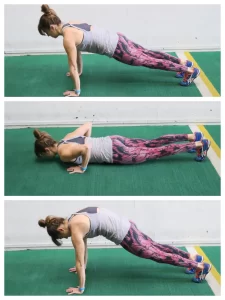
Standing Row
- Using the elastic band, create a loop that is three feet long, and tie the ends together.
- Connect the loop to a stable object, such as a doorknob.
- Bending your elbow at your side, hold the band as you would in the starting position.
- Pull your elbow back straight slowly while keeping your arm close to your side.
- Hold this position for a few seconds.
- Return to the starting position slowly
- Then relax.
- Repeat these exercises five or ten times.
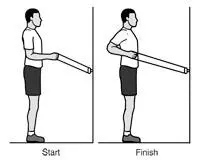
Elbow Flexion
- Maintain a straight posture while distributing your weight equally across both feet.
- As you can see, keep your elbow close to your side and gradually raise the weight to your shoulder.
- For a few seconds, hold on.
- Return to the starting position slowly
- Then relax.
- Repeat these exercises five or ten times.
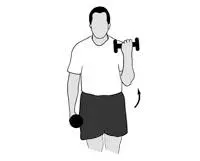
Extension of the Elbow
- As you take a tall stance, balance your weight equally on each foot.
- Raise and bend your elbow with the weight behind your head.
- To support your arm, place the other hand over your upper arm.
- When you bring the weight overhead, slowly extend your elbow.
- Keep this position for a few seconds.
- Return to the starting position by lowering your arm behind your head slowly.
- Then relax.
- Repeat these exercises five or ten times.
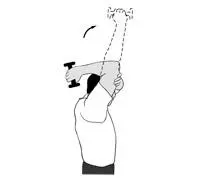
Internal and External Rotation
- On a flat surface, rest on your back.
- Stretch your arm straight from your shoulder, bending the elbow 90 degrees to point your fingers upward.
- Keeping your elbow bent and positioned on the ground, slowly move your arm at the suggested angle.
- If you feel pain at 90°, move your elbow down to a 45° angle.
- Return to the starting position slowly
- Then relax.
- Repeat these exercises five or ten times.
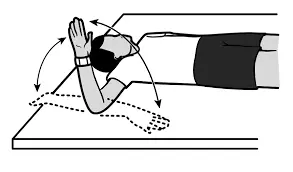
Advice for a Strong Rotator Cuff:
- Before working out, perform some stretches.
- Before an activity, throwing athletes usually stretch their shoulders.
- Increase the force of the rotator cuff.
- Strengthen your lower limb and core muscles.
- Get back to throwing with proper technique.
- Use as much ice and pain relievers as necessary.
Safety Factors to Consider:
- Before starting an exercise program for a rotator cuff injury, you should speak with your doctor.
- Warm up your muscles with a heating pad or a warm shower before performing these exercises.
- Use ice or a cold compress to reduce any soreness that may arise from completing these exercises.
- On the other hand, stop the exercises and notify your doctor if you feel a sharp pain.
What safety measures are necessary when exercising?
- As you work out, keep your posture correct.
- Warm up fully before beginning any exercise.
- Exercise should be discontinued if you feel any ache or discomfort.
- Take a break in between workouts.
- Avoid doing hard workouts.
- Achieve the Correct Balance.
- Stay hydrated.
What times do you not work out?
- Extreme burning in the muscles
- It feels like you’re sick.
- If you experience any numbness or pain.
- Elevated Body Temperature
- If working out is painful, give up.
If you have a rotator cuff injury, stay away from these exercises.
If you love using the free weights at the gym to work out your rotator cuff issues, you’ll quickly learn that lifting anything straight over your head is something to really avoid. It’s probably going to hurt pretty well.
However, you might be surprised by a few exercises that cause additional strain on your injured shoulder. Among those that are on the list are,
Deadlifts: “You’re pulling your arm off of its socket by using these heavyweights.” “The rotator cuff has been under a great deal of strain.”
Shrugs: Another example of weight bearing down on your shoulder.
Squatting: Rotator cuff strain is caused by placing the bar across your shoulders and extending your arms.
Summary
The human body is a complex system of interrelated components that allow us to perform our daily tasks. One of the most important components of this system is our rotator cuffs. A significant collection of muscles and tendons make up the rotator cuff, which surrounds the shoulder joint and permits our arms to carry out a range of functions.
A rotator cuff injury may result in loss of motor function and require months of nonstop rehabilitation. You can perform exercises that can harm you if done improperly as well as ones that will strengthen your rotator cuff muscles and reduce your risk of injury.
The discomfort and pain that may have been caused by impingement or tear can be greatly reduced by performing exercises to stretch and strengthen the rotator cuff. Your physical therapist should supervise you while performing these exercises to ensure you are doing them correctly and getting the benefits. You can resume activities that previously looked unachievable and help your injured shoulder return to normal function with the support of a recommended physical therapy program. The rotator cuff muscle is crucial to your shoulder’s range of motion.
After suffering a rotator cuff injury, such as a rupture or strain, you can improve your range of motion and gain strength by performing targeted stretches and exercises. These exercises can also help to speed up the healing process and lower the likelihood of developing new issues.
FAQs
Muscle-toning exercises may cause only mild soreness. You can try applying ice to the shoulder to help reduce the pain, but you should stop exercising for a few days if the pain is severe or sharp.
Like other muscles in our body, the rotator cuff muscles need time to recover between sessions, which is why most people don’t exercise them every day. Still, physical activity can often improve your flexibility and muscle strength. Before beginning any rotator cuff exercises, stretch and warm up as needed. You should also see a physical therapist or doctor to prevent further injury.
Initially, exercises that require lifting weights or any kind of movement should be avoided by those with shoulder injuries. Strike out any specific weight training exercises, such as pull-ups and overhead presses, at the gym or throwing a ball.
Try to avoid painful activities and stop doing things that cause you pain. Until the pain in the shoulder goes away, avoid lifting large weights or performing overhead exercises. Applying ice therapy to the shoulder can aid in pain relief and improved mobility. To relieve pain, use over-the-counter medications such as acetaminophen (Tylenol) or ibuprofen (Advil, Motrin IB, etc.).
If the shoulder joint is painful in a dull ache.
Frustrate sleeping.
Too small to reach behind your back and too difficult to comb your hair.
Be followed by a weakness in the arms.
After 6 to 12 weeks of rehabilitation, the majority of patients with rotator cuff tendinitis experience an improvement in pain and function. After several weeks of physical therapy exercises, the majority of doctors will suggest additional testing if the patient’s shoulder pain does not improve.
Following a rotator cuff injury, such as a tear or strain, performing targeted stretches and exercises can help you improve your range of motion and gain strength. In addition to aiding in the healing process, these exercises can lower the likelihood of developing new issues.
Exercises targeting the rotator cuff are essential for both injury prevention and treatment. They increase flexibility and muscle strength.
The tendons of the teres minor, subscapularis, supraspinatus, and infraspinatus compose the rotator cuff. One type of tendon inflammation is rotator cuff tendonitis. This condition commonly exists alongside shoulder impingement and may arise from long-term, repetitive overuse or appear suddenly following an injury.
Improving shoulder mobility with frequent stretching and exercise is the best strategy to prevent rotator cuff irritation. Good flexibility and joint movement balanced with sufficient strength are necessary for good mechanics, which are ultimately put together through coordinated movement.
In order to maintain stability and a full range of motion, the rotator muscles tighten during arm movements, preventing the humeral head from dropping. Rotator cuff muscles promote abduction, medial rotation, and lateral rotation, which in turn contributes to the mobility of the shoulder joint.
Rotator cuff disorders may worsen if left untreated, either with rest and rehabilitation or surgery. Your pain may increase with time. Your shoulder may become weaker and lose range of motion, which will make it more difficult to carry out daily tasks.
Doorway stretch
Pendulum
Passive Internal Rotation
Passive External Rotation
Sleeper Stretch
Wall push-ups
In order to treat rotator cuff damage, doctors usually advise resting the muscles and tendons in your shoulder.
It is well-known that most people prefer to postpone surgery unless it is absolutely necessary. Fortunately, physical therapy (PT) often results in similar health improvements without the need for risky surgical procedures, costly equipment, long recovery periods, or long stays in the hospital.
Strengthening exercises are the primary treatment for rotator cuff tears. But, in certain situations, rotator cuff surgery might also be necessary if your injury is severe.
The majority of doctors advise having a back sleep. You won’t strain or force your injured shoulder into an uncomfortable position when you lie on your back. If possible, try sleeping in a comfortable recliner or with an offset pillow during the first few days or weeks when the symptoms are at their worst.
With continued use of the shoulder joint, tendinitis and chronic rotator cuff tendon pain can develop gradually and get worse over time. On the other hand, acute rotator cuff tears usually cause sudden, severe shoulder joint weakness and pain.
Ice.
An inflamed tendon may benefit from the application of ice or cool packs, which can help compress blood vessels and reduce local circulation. Inflammation is decreased by doing this. Additionally, it can numb the region, decreasing pain.
The most common reason for shoulder pain and being unable to participate in sports for people of all ages is rotator cuff injuries. The most severe kind of rotator cuff injury is rotator cuff tendonitis. The arrangement of muscle and bone in the shoulder is unique.
Your shoulder’s capacity to rotate both internally and externally must be powerful and long-lasting. It is generally necessary for you to perform a minimum of five rotator cuff exercise sessions per day, each lasting approximately five minutes.
Many of the shoulder issues you could experience can be avoided with proper posture, stretching, and some very basic strengthening exercises.
People with tendonitis in the shoulder frequently recover quickly. It may take a week for conservative treatments to start working, and several more weeks will pass before the inflammation completely goes away. However, age, underlying medical issues, and other factors can affect how long it takes to heal.
Within a day or two, if your doctor gives you the all clear, begin an exercise regimen to strengthen the muscles surrounding the sore joint. Start the process with an extended warm-up to minimize cell stress. Next, try using an elastic exercise band or light weights. Start out slowly.
References:
- Ortho Info – AAOS – Rotator Cuff and Shoulder Conditioning Program (n.d.). The rotator cuff and shoulder conditioning program is part of the recovery section of orthoinfo.aaos.org.
- B. S. Pt (2023, Jan. 16). Exercises for Isometric Shoulders. Verywell Medical. Isometric shoulder exercises (#2696516) – https://www.verywellhealth.com/text=Shoulder%20Extension%Isometric%20Text=Keep%20your%20elbow%20 percent in a rowAfter 20 seconds at 20°C, release the pressure gradually.
- Fletcher, J. (February 13, 2019). How to shield the rotator cuff from harm. The takeaway from https://www.medicalnewstoday.com/articles/324435 Reference within the text: Fletcher, 2019
- Barta, K. ( February 13, 2024). Rotator cuff workouts for strengthening or healing. Healthline. Doorway Stretch: https://www.healthline.com/health/rotator-cuff-injury-stretches Reference within the text: Barta, 2024
- Exercises for the Rotator Cuff | Kaiser Permanente (n.d.). He.rotator-cuff-exercises.ad1509, Kaiser Permanente, https://healthy.kaiserpermanente.org/health-wellness/health-encyclopedia In-text Citation: (Kaiser Permanente, n.d.) Rotator Cuff: Exercises
- The top five rotator cuff exercises and worst exercises can be found at https://www.hand2shouldercenter.com. In-text Reference: (2023)
- Top rotator cuff exercises for stretches and strengthening: https://www.yorkvillesportsmed.com/blog Reference inside text: (Jey back, 2019)
- Image 4, Routines, workouts, and exercises for resistance band lawn mower row. (As of now). Resistance-band lawnmower row exercises can be found at https://www.workoutsprograms.com/ Internal Reference: (RESISTANCE BAND LAWN MOWER ROW – Activities, Routines and Workouts, n.d.)
- Image 5, A. A. C. H. October 9, 2022. 21 Supine flexion of the arms and legs. YouTube. /watch?v=QfUK-6BTd-c on YouTube In-text Reference: (2022)
- Image 12, Rotator Cuff Problems: Exercises You Can Do at Home. (As of now). Conditional pages in the MyHealth.Alberta.ca/Health/pages. asp? hwid=ue4829 Reference inside text: (Rotator Cuff Issues: Activities You Can Perform at Home, n.d.)
- Image 16, YouTube. (n.d.). Watch this video at https://www.youtube.com/watch?app=desktop&v= (YouTube, n.d.) In-text Citation
- Image 17, Barta, K. ( February 13, 2024). Rotator cuff workouts for strengthening or healing. Healthline. Doorway Stretch: https://www.healthline.com/health/rotator-cuff-injury-stretches
Reference within the text: Barta, 2024 - Image 19, Horizontal Abduction with External Rotation (Prone) is a strengthening technique. (As of now). The following link: https://iris.hattiesburgclinic.com/patadv/exkit/Orthopedic/English/0290000894shld076m_English.html Internal Reference: (Fortifying: Lateral Abduction – Combined With External Rotation (Sideways), n.d.)
- Image 20, D. L. Kin (2021, Dec. 27). How to Unfreeze Shoulder Without Expense – For Health And Fitness https://medium.com/in-fitness-and-in-health/how-to-fix-frozen-shoulder-without-spending-a-dime-be89e43ef718 Citation inside the text: Kin (2021)
- Image 21, www.isdfoundation.org.ng is the website of the Institutional and Sustainable Development Foundation (n.d.). The link is https://isdfoundation.org.ng/?o=text-exercises-after-breast-surgery-rr-0jnlMKT1.
- Image 22, M. K. Qaramah (2019). Altarul Reîntregirii, 3, 149–161. http://fto.ro/altarul-reintregirii/wp-content/uploads/2020/05/14.-Andrei-PETRACHE-AR3-2019.pdf. The article’s DOI is 10.29302/ar.2019.3.14.
- Image 23, New York Shoulder Exercises | Adhesive Capsulitis Exercises. (n.d.). Jaspal The website of Ricky Singh, M.D. has information about adherent capsulitis
- Image 28, Lefkowith, C. (2016) 12 Dec. Elevate Your Game. Strength Redefined. https://push-up-plus.redefiningstrength.com/

